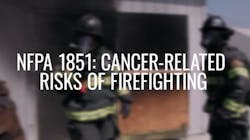Manufacturer's Corner: TargetSolutions Releases New Course Covering NFPA 1851
Manufacturers’ Corner content is sponsored by manufacturers and suppliers serving the fire service industry.
Despite the inherent dangers that come with the job of fighting fires and saving lives from critical situations, cancer remains one of the leading causes of line-of-duty deaths in the fire service. This silent killer has been linked to specific carcinogenic agents and was proven to lurk in unexpected places, such as firefighters’ own personal protective equipment (PPE).
To help reduce the cancer risks of firefighting, TargetSolutions is proud to release an all-new course for the fire service: NFPA 1851 – Cancer-Related Risks of Firefighting.
“TargetSolutions recognizes just how serious of an issue this is for today’s fire service,” said Marc Scheipe, who serves as TargetSolutions’ executive vice president. “With that understanding comes a responsibility to create training courses that can make a difference. This course outlines the importance of care and cleaning for turnout gear, how to maintain and inspect PPE (personal protective equipment), and best practices for decontamination, isolation, and reporting of equipment-related issues. The course goes a long way to educate fire service members on how they can mitigate risk.”
Course overview
Based on the 2014 NFPA standard on Selection, Care, and Maintenance of Protective Ensembles for Structural Fire Fighting and Proximity Fire Fighting, NFPA 1851 – Cancer-Related Risks of Firefighting delivers valuable lessons in firefighter cancer prevention. This two-hour course was authored by fire service instructor and subject matter expert, Paul Costello, who details current information regarding firefighter cancer risks and explains important measures in ensuring safety.
Course objectives
After completing TargetSolutions’ NFPA 1851 course, personnel will be able to achieve the following:
- Interpret important terminology as it relates to the NFPA 1851 Standard
- Explain how protective ensembles interfaces intersect with organs and the lymphatic system
- Recognize known carcinogenic agents and cancers associated with the fire service industry
- Employ best practices to reduce the risk of occupationally-related cancers
- Comprehend current legislation as it relates to fire-service-cancer diseases and diagnoses
These important topics are covered in 13, video-driven lessons and are guided by an in-course instructor. To ensure personnel can employ these best practices, frequent in-course quizzes and an end-of-course exam test for comprehension.
“Collectively, professionally, we’ve known that there was a correlation between firefighting and cancer for many years. This intrinsic knowledge that the profession has harbored is based on our own observations and losses to cancers at rates that seemed higher than those experienced outside of the fire service,” Costello said. “In the last few years, the data has become increasingly clearer, not only validating the correlation to firefighting, but in many instances the causation of several cancers as well.
“Having this knowledge in hand, a firefighter can identify the risk factors that he or she is exposed to every day and what can be done to mitigate them.”
For questions about TargetSolutions’ all-new course firefighter cancer prevention training course, please contact us today at (800) 840-8046.







